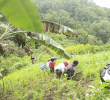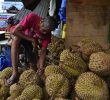DAVAO CITY, Philippines – Davao’s City Agriculturist Office (Cagro) has started a campaign to help local farmers prepare for the El Niño phenomenon that can cause a dry spell.
The local government has also started preparing and improving rainwater catchments and irrigation facilities as one of the priority projects in anticipation of a drought.
City hall has already put in place hundreds of rainwater catchment areas in upland areas and seeks to expand them to other areas to cushion the impact of El Niño and avoid a repeat of the city’s experience more than two decades ago when the weather phenomenon caused a drought in two-thirds of the country.
Tranquilina Alibango, a rice and vegetable farmer in Wangan, Davao, said she was worried because her family suffered an eight-month dry spell in 2016. She recalled that their crops died, and they could only sell a small portion of their harvest.
The Department of Agriculture (DA) in the Davao Region said that in 2016, the El Nino phenomenon affected a total of 8,429 farmers in the region who lost some 14,951 metric tons of rice worth P219.983 million and 9,249 metric tons of corn worth P77.210 million.
The Philippine Atmospheric, Geophysical and Astronomical Services Administration (PAGASA) in the Davao Region has warned the public of rising temperatures ahead as the El Niño weather condition starts in the third quarter or from July of this year.
PAGASA chief meteorological officer Lolit Vinala said the delayed onset of rainfall and the likelihood of below-normal rainfall conditions could bring a dry spell in some areas of the country.
In an El Niño Watch issued by the state weather bureau on March 24, the probability of the development of this weather condition is at 55% or more and may develop within the next six months.
El Niño is characterized by unusually warm ocean surface temperatures in the central and eastern equatorial Pacific.
Vinala said the El Niño could result in a decline in soil moisture, a decline in crop production, reduced stream flows and groundwater supply, reduced water supply, less rainfall in forest resources, fish kill and red tides, less water for hygiene and sanitation, and poor air quality leading to pulmonary diseases.
The local agriculture office said it has stepped up an information dissemination campaign at the barangay levels so that people can prepare for the onset of El Niño.
They activated the proactive phase for the El Niño phenomenon from March up to June to mitigate the risk and impacts on areas that would be hit hard by an anticipated dry spell.
“We are checking their irrigation and water supply. We have identified the expansion of rainwater catchments and irrigation facilities as one of the priority projects to be implemented under the pre-active phase,” city agriculturist Edgardo Haspe said.
Davao City has built 258 rainwater catchment areas in upland areas, particularly in Marilog, and seeks to expand them to other areas like Paquibato, Calinan, and Baguio.
At present, Davao City and the region have been seeing sunny days with some light rain and localized thunderstorms which, according to PAGASA, are due to the easterlies.
“We are still in the neutral condition indicating that there is neither an El Niño nor La Niña,” Vinala said.
From 1997 to 1998, the country experienced a severe El Niño, which led to a reduction in rainfall levels to half of the historical average and caused drought in two-thirds of the country.
Meanwhile, the Davao City Disaster Risk Reduction Management Office (CDRRMO) has urged the public to monitor weather advisories.
CDRRMO head Alfredo Baloran said weather disturbances such as thunderstorms are to be expected in the latter hours of the day and at night in the coming weeks, despite the dry season.
“We have the easterlies. The easterlies will bring weather disturbances like thunderstorms,” he said.
Amid the scorching heat, Davao City saw heavy rainfall on April 16, which caused water levels in several tributaries and creeks to rise to alarming levels.
The Talomo River, for instance, rose to a near-critical level while the Matina River’s water elevation reached the critical level, prompting the local disaster office to call for the preemptive evacuation of 15 families in a community in the village of Matina. (originally posted on rappler.com)
Lucelle Bonzo is an Aries Rufo Journalism fellow.
davao city, El Niño









